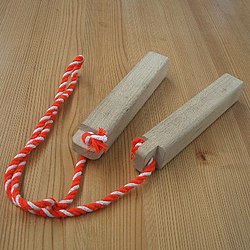Hyōshigi
 | |
| Other names | Concussion Blocks, Kabuki Blocks, Kabuki Clappers[1] |
|---|---|
| Classification | Concussion Idiophone[2] |
Thehyōshigi(Phách tử mộc)is a simpleJapanesemusical instrument,consisting of two pieces ofhardwoodorbamboooften connected by a thin ornamental rope. The clappers are played together or on the floor to create a cracking sound. Sometimes they are struck slowly at first, then faster and faster.
Theater
[edit]Hyōshigiare used in traditional Japanesetheaters,such asKabukiandBunrakutheater, to announce the beginning of a performance.[2]Thekyogen-kata usually plays the hyoshigi at the start of comedic plays.[3]It can be used to attract the attention of the audience by conductors for theater and even athletic and juggling performances.[4]Hyōshigiare also used to stress confusion,[2]and other dramatic moments,[5]in the play.
Religion
[edit]It is also often used to signal the starting or the end of parts of festivals, especially in the directing of themikoshi.
Hyōshigiis combined with other traditional Japanese instruments inmikagura-uta,or cycle of songs, which is characteristic of theTenrikyoreligion.[6]
Other uses
[edit]The clapping instrument was also used inKamishibaito gather children so that theKamishibaiman could sell candy and entertain them with his story.[7]
The wooden percussion instrument was also used by night-watchmen when patrolling the streets.[4]
Volunteer Fire Corps (Shōbōdan) patrols use the Hyoshigi during their night-patrols (yomawari) warning people about the danger of fire.[8]
References
[edit]- ^James Holland (16 September 2005).Practical Percussion: A Guide to the Instruments and Their Sources.Scarecrow Press.ISBN978-1-4616-7063-6.
- ^abcBlades, James; Anderson, Robert."Clappers".Grove Music Online. Oxford Music Online.Oxford University Press.
- ^Saltzman-Li, Katherine (2010).Creating Kabuki Plays: Context for Kezairoku, Valuable Notes on Playwriting.Ipswich, MA: Leiden: Brill. p. 47.ISBN9789004121157.
- ^abSir Francis Taylor Piggott; Thomas Lea Southgate (1893).The Music and Musical Instruments of Japan.B.T. Batsford. pp.210.
- ^Karen Brazell (1998).Traditional Japanese Theater: An Anthology of Plays.Columbia University Press. p. 309.ISBN978-0-231-10873-7.
- ^Kishibe, Shigeo; Hughes, David; de Ferranti, Hugh; Adriaansz, W.; Thompson, Robin; Rowe, Charles; Berger, Donald P.; Malm, W.; Waterhouse, David; Marett, Allan; Emmert, Richard; Koizumi, Fumio; Tanimoto, Kazuyuki; Kanazawa, Masakata; Fujie, Linda; Falconer, Elizabeth."Japan".Grove Music Online. Oxford Music Online.Oxford University Press.
- ^De las Casas, Dianne; Chow, Philip (2006).Kamishibai Story Theater: The Art of Picture Telling.Westport, Conn: Teacher Ideas Press. p. 1.ISBN9781591584049.
- ^Gordenker, Alice (20 December 2011)."Yomawari".The Japan Times.Retrieved19 April2021.
